 |
 |
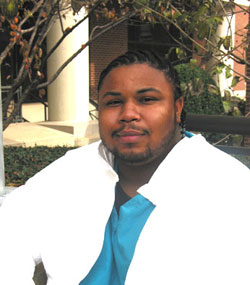
|
|
Maurice B., Laboratory Animal Caretaker, Priority One Services, Central Animal Facility, National Institutes of Health, Bethesda, Maryland
|
1. I chose this career because...
2. My typical workday involves...
3. What I like best and least about my work …
4. My career goals are...
5. When I'm not working, I like to...
6. A funny story...
|
|
1. I chose this career because...
|
Back to Top

|
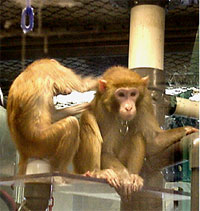
|
|
A rhesus nonhuman primate grooming another
|
I chose to become a laboratory animal caretaker because I’ve always liked interacting with animals. I especially like cats and grew-up with them. I have a friend who is an animal technician. Knowing how much I liked animals, he told me about this job. Now I take care of rhesus and cynomolgus nonhuman primates, scientifically known as Macaca mulatta and Macaca fascicularis, respectively. I enjoy the fact that these animals have different personalities, just like people do.
How did I become a Laboratory Animal Caretaker?
I began my career after high school. I started as a facility support technician and was trained on the job to properly care for laboratory animals. Four months later, I was promoted to an animal technician position.
The nonhuman primates and me
I was a bit nervous the first time I interacted with the animals. Nonhuman primates need to get to know you before you can interact with them. I avoided direct eye contact with the animals because they interpret that as a threat. They watched me every day and gradually started to feel comfortable with me. Even though they can get comfortable with you, you can never get too comfortable with them. That’s because they sometimes display aggressive behaviors, like flashing their canines, jumping up and down, and grabbing for you.
|
|
2. My typical workday involves...
|
Back to Top

|
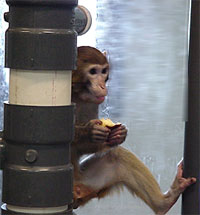
|
|
Snack time: rhesus nonhuman primate holding apple
|
My typical workday revolves around caring for the animals.
My Major Tasks Include:
Health Monitoring
- Making sure the animals are behaving normally and appear healthy
- Making sure their environment is safe and comfortable by monitoring room temperature, humidity, and cleanliness
Feeding (1st feeding: 6:30 – 7:20 a.m.; 2nd feeding: 2:00- 3:00 p.m.)
- Checking automatic water lines to make sure they have no flow problems
- Checking the feeding instructions for each animal
- Giving each animal the proper amount of biscuits and treats
- Documenting the feeding information in each animal’s records
Documenting
- Laboratory animal caretaker tasks and responsibilities are guided by detailed standard operating procedures (SOPs). It is very important that we document everything we do for the animals.
Cleaning
- Cleaning each animal’s housing environment
- Disinfecting animal rooms and common-use areas
Checking
- We check on the animals at regular intervals each day to ensure their safety and well-
being. We pride ourselves in providing the animals with the highest quality of care
possible.
Special equipment I use:
- We wear Tyvek® coveralls, goggles, gloves, a face mask or shield, and steel-toed shoes. This personal protective equipment (PPE) protects us and the animals from potential hazards.
- Twice a day we use a lixit pole to verify that the water valve (lixit) for each animal is providing unrestricted access to fresh drinking water.
- In addition to pair-housing the nonhuman primates, we provide them with a variety of environmental-enrichment items to promote psychological well-being. These items include gnawing toys, mirrors, and a variety of fruits, vegetables, and frozen and foraging puzzle treats. They love foraging and playing with the mirrors.
|
|
3. What I like best and least about my work …
|
Back to Top

|
What I like best about my job are the learning experiences and the chance to do more than just routine tasks.
What I like least about my job is not being able to perform certain duties because I lack the specialized training and experience required for those tasks. I’m working on that now through the American Association for Laboratory Animal Science (AALAS).
|
|
4. My career goals are...
|
Back to Top

|
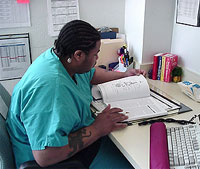
|
|
Maurice B. studying for LAT exam
|
I am currently certified as an assistant laboratory animal technician (ALAT), under the auspices of AALAS. My immediate career goal is to obtain certification as a laboratory animal technician (LAT). After that, I plan to work towards the technologist certification. (See explanations below.)
There are three levels of animal care certification:
- Assistant Laboratory Animal Technician (ALAT)
- Laboratory Animal Technician (LAT)
- Laboratory Animal Technologist (LATG)
For each level of certification, you must have a certain amount of work experience in an animal care and use program, study material relevant to the field, and then pass a certification exam. The amount of experience and knowledge required increases with each level of certification. It’s worth the effort, though, because you become eligible for positions with more responsibilities and increased pay.
|
|
5. When I'm not working, I like to...
|
Back to Top

|
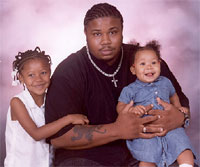
|
|
Maurice B. with daughters
|
When I’m not working, I’m involved with sports. If I’m not watching them on TV, I’m playing them. I play a lot of football and basketball. I also enjoy spending time on the playground with my two little girls.
|
|
6. A funny story...
|
Back to Top

|
|
|
The nonhuman primates really keep you on your toes. One of the first times I was in the animal room by myself, without a trainer, a funny thing happened. While I was feeding a nonhuman primate, another animal nearby stole the work keys that were attached to my scrubs. He started jiggling the keys and jumping around, almost as if he was bragging. I called my supervisor, and together, we finally got the keys back by dragging them out with a lixit pole. Everyone still teases me about this incident.
|
|
|
|
 |